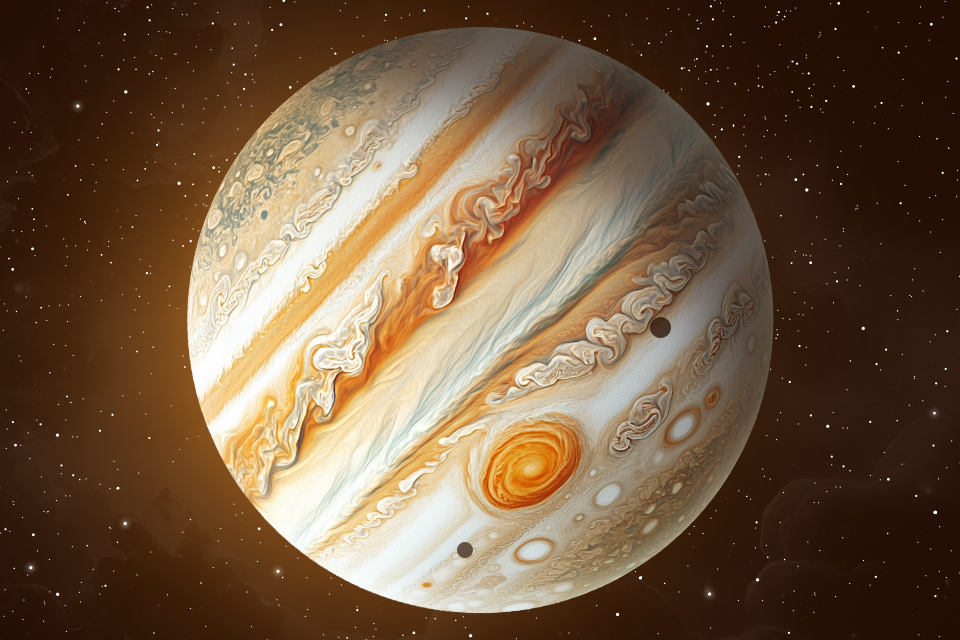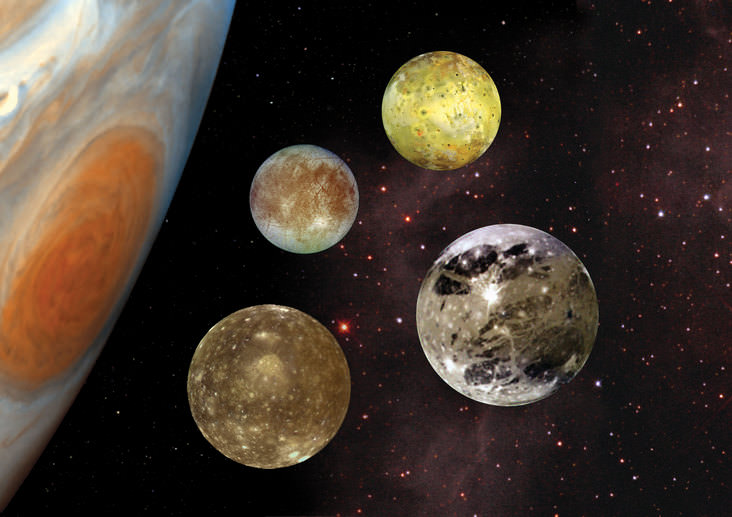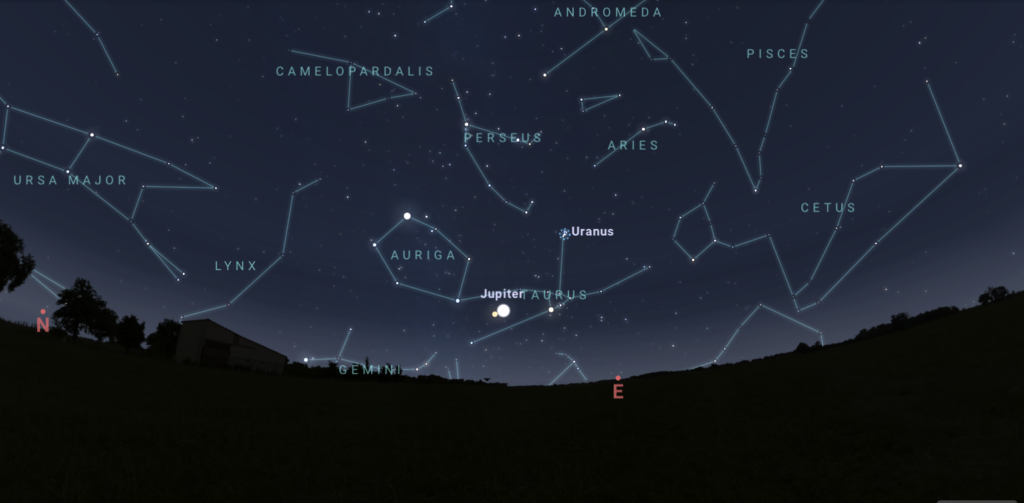Authors: Oleksandr Burlaka and Natalia Virnina
On the night of August 17-18, a rare phenomenon will be observed in Ukraine: the passage, or, as astronomers say, transit, of the shadows of two of Jupiter’s moons, Io and Europa, across Jupiter’s disk. We’ll tell you how and when you can see it.

What is the transit of Jupiter’s moons?
Jupiter is the largest planet in the Solar System. It is a gas giant located five times farther from our luminary than the Earth, but nevertheless it is one of the brightest celestial bodies. On the night of August 17-18, Ukrainian astronomy enthusiasts will have a rare opportunity to observe the simultaneous transit of the shadows of two satellites across its disk.
Today, Jupiter has 95 known moons. However, there are 4 largest among them, which are called Galileo’s, as they were discovered by the famous Italian astronomer: Io, Europa, Ganymede, and Callisto. It is their rotation around the giant planet that amateurs like to follow. When one of these bodies passes between the Earth and the gas giant, we observe it as a passage along its disk and call it a transit.
It is important to distinguish between the transit of the satellite itself and its shadow. These two events are related and mostly do not diverge much in time. However, sometimes the transit of the shadow can occur, but the transit of the satellite itself does not.

When a satellite of Jupiter is between the planet and the Sun, it casts a shadow on its disk. From the Earth, through an amateur telescope, the shadow looks like a tiny black circle against the background of the bright planet.
How often do shadows transit Jupiter’s disk?
Fortunately, the Earth is much closer to the Sun than Jupiter. Therefore, through our telescopes, most of the time it looks like a full or almost full disk, almost never showing us its dark side. That’s why we can observe transits of the satellites’ shadows across Jupiter’s disk on a regular basis.
Io’s rotation period is 1.76 days, Europa’s is 3.5 days, Ganymede’s is 7.15 days, and Callisto’s is 16.6 days.
It seems that the transit of a satellite’s shadow across Jupiter’s disk can be observed almost every day. Indeed, there are about 7-9 transits per week. But for each individual location, it is usually possible to see only 1-3 of them per week. Double shadow transits are a much rarer event. They occur in series for 1-2 months with intervals of approximately the same duration. And although there may be about a dozen transits during the series, only 1-2 will be available to us for observation.
The possibility of observing a double transit of the shadows of the Galilean satellites across Jupiter’s disk depends on several factors. First, Jupiter must be far from the Sun and at a sufficient height above the horizon, preferably at least 20°. Secondly, it should be dark at the place of observation, or at least twilight. Observing transits during daylight hours is also possible, but this option is only suitable for experienced observers who have the appropriate equipment. And, thirdly, of course, you have to be lucky with the weather!
The triple transit of the shadows occurs once in years, and sometimes decades for a particular location of the observer. Due to the fact that Io, Europa, and Ganymede are in a 1:2:4 resonance and due to the specifics of their orbital motion, all three satellites never appear in front of Jupiter. Therefore, the most distant moon of Jupiter, Callisto, must always participate in triple transits. Due to the great distance to Jupiter and the slight inclination of its orbit, we do not see the transit of its shadow at every revolution of Callisto. Such events occur every 6 years, for about 3 years.
And it is impossible to observe all four shadows of the Galilean satellites on Jupiter’s disk.
How to see the transit of the satellites’ shadows on Jupiter’s disk?
On the night of June 17-18, there will be a rare moment when the double transit of the shadows of Io and Europa across Jupiter’s disk can be seen in Ukraine. However, to witness it, you will need a telescope with a diameter of at least 150-200 mm.
Io’s shadow will be the first to enter Jupiter’s disk at 00:37 Kyiv time (21:37 GMT). But at that time, Jupiter will just begin to appear from behind the horizon. At 01:49 (22:49 GMT), the shadow of Europa will gradually begin to creep onto the giant’s disk, beginning a double transit of the shadows. Jupiter will be about 11° above the horizon at that time. The planet will be easy to see as the brightest object in the constellation Taurus, not far from the bright orange star Aldebaran. At the same time, it will be possible to see tiny Io very close to Jupiter. The satellite itself will be on the disk in a few minutes – at 01:52 (22:52 GMT).

The two shadows will gradually crawl across the planet’s disk for an hour, and at 02:47 (23:47 GMT) Io’s shadow will leave the disk, completing the double transit. The satellite itself will still be on the disk, as will the shadow of Europa. You will notice how Europa is gradually approaching Jupiter. At this point, the planet will be at an altitude of about 22°. At 04:04 (01:04 GMT), the moon Io will leave the disk, and at 04:17 (01:17 GMT), Europa’s shadow will also leave the disk. And only 4 minutes later, at 04:24 (01:24 GMT), Europa will begin a transit that will last until dawn and end at 05:54 (02:54 GMT).
The success of the observations depends on the state of the atmosphere. Jupiter’s visible diameter is currently 36“, and its shadows are just under 1”. Therefore, you should be patient and catch the moments of the best visibility.


